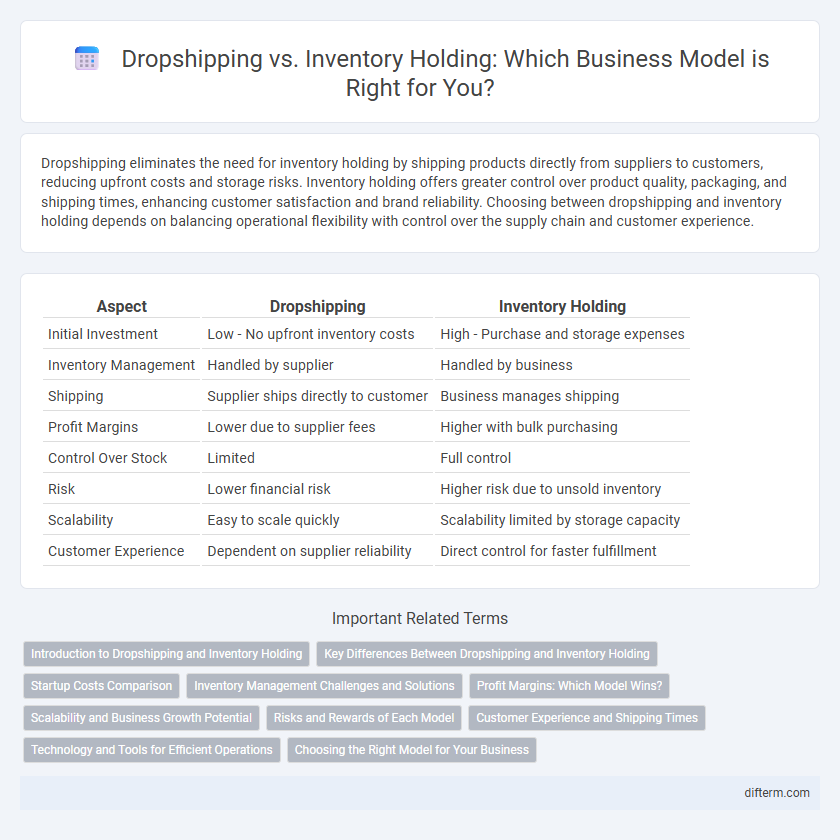Dropshipping eliminates the need for inventory holding by shipping products directly from suppliers to customers, reducing upfront costs and storage risks. Inventory holding offers greater control over product quality, packaging, and shipping times, enhancing customer satisfaction and brand reliability. Choosing between dropshipping and inventory holding depends on balancing operational flexibility with control over the supply chain and customer experience.
Table of Comparison
| Aspect | Dropshipping | Inventory Holding |
|---|---|---|
| Initial Investment | Low - No upfront inventory costs | High - Purchase and storage expenses |
| Inventory Management | Handled by supplier | Handled by business |
| Shipping | Supplier ships directly to customer | Business manages shipping |
| Profit Margins | Lower due to supplier fees | Higher with bulk purchasing |
| Control Over Stock | Limited | Full control |
| Risk | Lower financial risk | Higher risk due to unsold inventory |
| Scalability | Easy to scale quickly | Scalability limited by storage capacity |
| Customer Experience | Dependent on supplier reliability | Direct control for faster fulfillment |
Introduction to Dropshipping and Inventory Holding
Dropshipping is a retail fulfillment method where a store sells products without keeping them in stock, instead transferring customer orders directly to a third-party supplier who ships items to the customer. Inventory holding involves purchasing and storing products in a warehouse before selling, allowing for greater control over stock and faster shipping times. Businesses weigh dropshipping's low upfront costs against inventory holding's potential for higher profit margins and improved quality control.
Key Differences Between Dropshipping and Inventory Holding
Dropshipping eliminates the need for inventory storage by directly shipping products from suppliers to customers, reducing upfront costs and minimizing risk. Inventory holding requires purchasing and storing products, allowing greater control over stock availability, packaging, and shipping speed but increasing capital investment and warehousing expenses. The key difference lies in inventory management responsibility and financial commitment, impacting cash flow, scalability, and customer experience.
Startup Costs Comparison
Dropshipping requires significantly lower startup costs since it eliminates the need for upfront inventory purchases and warehouse expenses, making it ideal for entrepreneurs with limited capital. Inventory holding demands higher initial investment in stock acquisition, storage, and inventory management systems, which can strain cash flow during early stages. Considering financial flexibility, dropshipping offers a cost-efficient model for startups aiming to minimize financial risk.
Inventory Management Challenges and Solutions
Dropshipping eliminates the need for inventory holding by relying on suppliers to fulfill orders directly, reducing storage costs and minimizing stock management risks. However, this model faces challenges such as supplier reliability, longer shipping times, and limited quality control, which can impact customer satisfaction. Inventory holding requires robust stock management systems, forecasting accuracy, and warehousing solutions to prevent overstocking or stockouts, ensuring smoother operations and faster delivery.
Profit Margins: Which Model Wins?
Dropshipping typically offers lower profit margins, averaging around 10-20%, due to third-party handling and higher per-unit costs, while inventory holding can deliver profit margins of 30-50% by enabling bulk purchasing and direct control over pricing. Businesses adopting inventory holding benefit from economies of scale and better inventory management, which often translates into higher net profits despite upfront investment risks. Profit margin superiority largely depends on the scale of operations and market demand predictability, making inventory holding the preferred model for maximizing profitability in most scenarios.
Scalability and Business Growth Potential
Dropshipping offers high scalability with low upfront costs, allowing businesses to expand product range and markets without investing in inventory, which accelerates growth opportunities. Inventory holding requires significant capital and storage management but provides greater control over stock quality and fulfillment speed, supporting sustainable growth with consistent customer satisfaction. Choosing dropshipping enables rapid scaling, while inventory holding better suits businesses aiming for long-term brand control and operational stability.
Risks and Rewards of Each Model
Dropshipping minimizes upfront investment and reduces inventory risk since products are shipped directly from suppliers, but it often yields lower profit margins and less control over shipping times and product quality. Inventory holding allows for higher profit margins, greater control over product availability and packaging, but requires significant upfront capital and carries the risk of unsold stock and storage costs. Evaluating customer experience impact and cash flow management is crucial when choosing between dropshipping and inventory holding models.
Customer Experience and Shipping Times
Dropshipping often results in longer shipping times due to reliance on third-party suppliers, which can negatively impact customer satisfaction and brand trust. Inventory holding allows businesses to manage stock directly, offering faster, more reliable shipping and enhanced order accuracy that improves overall customer experience. Efficient inventory management and streamlined fulfillment processes play a critical role in minimizing delays and ensuring consistent delivery performance.
Technology and Tools for Efficient Operations
Dropshipping leverages advanced automation software and real-time inventory management tools to streamline order processing without the need for physical stock, reducing overhead costs and enabling rapid scalability. Inventory holding relies on warehouse management systems (WMS) and integrated supply chain technologies to optimize stock levels, forecasting accuracy, and fulfillment efficiency, ensuring product availability and faster delivery times. Utilizing AI-driven analytics and ERP platforms enhances decision-making and operational agility in both models, driving more efficient and data-informed business workflows.
Choosing the Right Model for Your Business
Choosing the right business model between dropshipping and inventory holding depends on factors such as capital investment, control over stock, and delivery speed. Dropshipping minimizes upfront costs and inventory risks by shipping products directly from suppliers, making it ideal for startups or businesses with limited funds. Inventory holding offers greater control over product quality and shipping times, suitable for businesses aiming to build brand trust and handle high-demand products efficiently.
Dropshipping vs Inventory Holding Infographic

 difterm.com
difterm.com